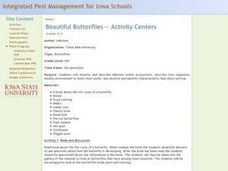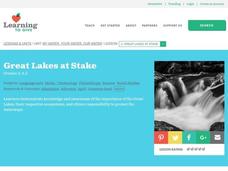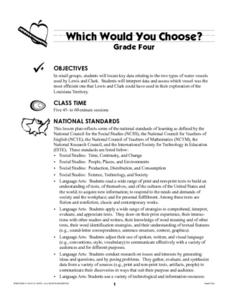Kenan Fellows
Use of Dichotomous Keys to Identify Stream Organisms
What kind of organisms are living in the stream? After an explanation on how to use a dichotomous key, groups of three to four use the keys to identify macroinvertebrates from a local freshwater stream. Using the the concept of...
Beyond Benign
Ecological Footprint
How does your lifestyle measure up in terms of your ecological footprint? Young ecologists examine their impact on the planet using an insightful online calculator. A short quiz asks users to rank the size of their homes, their energy...
Australian Government
The Great Artesian Basin
Covering 23% of the continent and holding 64,900 cubic kilometers of water, the Great Artesian Basin is the primary source of water for much of inland Australia. Using detailed student worksheets, experiments, and case studies,...
Arbor Day Foundation
Trees are Terrific...Inside and Out!
Trees are the star of a three-step unit celebrating Arbor Day. Step one takes an in-depth look into the structure of a tree, the process of photosynthesis, and the benefits of the leafy giants. Step two challenges scholars to create a...
Curated OER
Desert Adaptations
In this desert adaptations worksheet, students are given a water filled sponge which represents an animal. Students observe their "animal" for a 24 hour period and conserve the water in the sponge as best they can. They measure and...
Curated OER
WaterWeb
In this water instructional activity, students answer 10 multiple-choice questions about the water cycle. Students also describe how they think their community is involved in sustaining water resources and write a pretend radio...
Curated OER
The Open Ocean, What is it and How Does it Change?
Students investigate the ocean environment. In this ocean lesson plan, students discover the physical properties of the ocean. Over two days, students work in small groups investigating ocean maps and creating water currents.
Curated OER
Interactions Everywhere!
Students examine interactions within the environment and environmental engineering careers. They discuss and view photos of natural and manmade environments, explore various websites, create a web to identify interactions between living...
Curated OER
Mapping School Grounds
Middle schoolers map and analyze the natural and cultural environment of the school grounds. In small groups, they sketch the natural and cultural features of each side of the school building, create a map, participate in a class...
Curated OER
Beautiful Butterflies - Activity Centers
Learners describe habitats within ecosystems, describe how organisms modify environment to meet their needs, and identify characteristics for butterfly survival. In this butterfly lesson plan, students explore all aspects of the...
Curated OER
Great Lakes at Stake
Students explore conservation of the Great Lakes. In this geography and ecology lesson plan, students identify the Great Lakes on a map and view a video depicting the history and importance of these lakes. Students work in groups to...
Curated OER
Mini-Ponds
For this mini pond worksheet, students create a mini-pond ecosystem with soil, water, and plant life. Students let their ecosystem sit for a day and they observe a sample the next day. Students identify all the pond water microorganisms...
Curated OER
Sprinkles 5
In this environment worksheet, students read the information and complete the survey about their own local habitats and some of the others in Florida.
Curated OER
Ocean Life
Students explore the topics of ocean water salinity, ocean life zones, marine life classification, and ocean food chains. They observe demonstrations, conduct experiments, complete quizzes and handouts, and analyze key vocabulary.
Curated OER
Its OK To Be a Clod
Middle schoolers describe factors that affect the solubility of a chemical substance in seawater. In this sea environment lesson, student explain how information on the solubility of a substance can be used to measure water currents....
Curated OER
Seeds! What is Inside; How does it Grow and Why is it Important?
Students discover the importance of seeds in relationship to nature. In this plant growth lesson plan, students create a collection of seeds and discover the best type of environment to plant them. Students plant their own...
Curated OER
Which Would You Choose?
Fourth graders investigate two types of water vessels that were used by Lewis and Clark during the exploration of the Louisiana Territory. They interpret data to determine which vessel was more efficient.
Curated OER
How Do Plants Grow?
Students investigate plant growth. In this plant growth lesson plan, students investigate what would happen to plants if they did not have water and sunlight. Students conduct experiments to determine what plants need. Students create a...
Curated OER
What Are the Layers of the Rain Forest?
Students investigate the different levels of the rain forest by comparing it to an apartment. In this ecology lesson plan, students practice using forest related vocabulary words and complete a vocabulary data sheet. Students...
Curated OER
Pond Dipping: Worksheet 1
In this environment worksheet, students put a tick in the tally box when they find 1 of 7 pond creatures as they experiment with the process of going pond dipping.
Curated OER
Crops 2: What Plants Need to Grow
Students explore agriculture by participating in a plant growth activity. In this botany instructional activity, students discuss what types of plants grow in their local environment and what the plants need to survive. Students read...
Curated OER
Investigating Our Place in the World
Students study the concept of geography in a year long unit. In this geography unit, students participate in different activities that explain the spatial sense of the world, the physical landmasses and bodies of water, geographic...
Curated OER
Desalination: Creating a Solar Still
To better understand how solar power can aid in creating desalinated drinking water, the class creates a model still. They will build a model of a solar still, make observations, and discuss how the process works. While the idea behind...
Curated OER
Don't Water....Shed A Tear#145
Students examine the definition and attributes of tributaries and watersheds. They design a landscape which includes a mountain, a river, a lake and other appropriate items. They observe as the teacher pours water through the landscape...
Other popular searches
- Water and Our Environment
- Water Environment
- Conserving Water Environment
- Clean Water Environment
- Water and Environment
- Environment Water Use
- Environment Water Cycle























